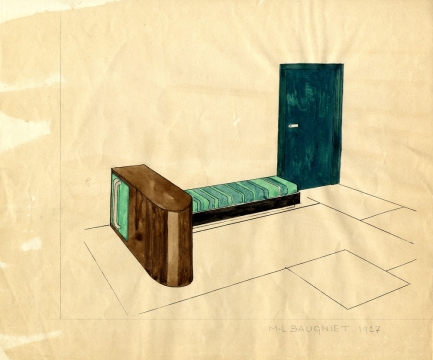Marcel-Louis Baugniet (1896-1995) was one of the most important Belgian avant-garde artists. The four sketches acquired by the King Baudouin Foundation bear witness to the diversity of his work. They are kept at the CIVA, the museum and archival centre devoted to architecture dating from the 19th to the early 21st century. The sketches represent an important addition to their Baugniet Fund.
Marcel-Louis Baugniet was a Belgian artist of many talents. In addition to painting, which he continued to do almost up to his hundredth birthday, he also created theatre costumes and sets, posters, tapestries, collages and furniture. He is known above all as a constructivist painter and champion of “Pure visual art”. This geometric abstract art form, associated with an elegant and delicate play on colours, is characteristic of his work.
Quite early on, Baugniet left his native city of Liege for Brussels, where he studied at the Fine Arts Academy alongside Magritte and Delvaux. He then went to Paris, where he was influenced by the Cubism of artists such as Léger and Zadkine and by the architect Le Corbusier. In Paris he also discovered the abstract art of Kandinsky, Mondrian and Delaunay and it was here too that his fascination with Russian Constructivism was born.
In 1922, Baugniet returned to Belgium and married the avant-garde dancer Akarova, for whom he created theatre costumes and sets that were full of geometric shapes. He also contributed to the Brussels modernist review 7 Arts, which aimed to provide a synthesis of all the arts and to position form as being more important than figuration. This movement took the name of “Plastique pure” (Pure visual art). During the 1920s, Baugniet was particularly active as an avant-garde artist, although he never received the recognition he deserved. Perhaps he was quite simply ahead of his time.
When the avant-garde artists gradually turned to abstract art, Baugniet concentrated on the decorative arts. In 1927, he founded an interior design boutique together with the Dutch architect Ewaud Van Tonderen. The sketch Projet de maquette dates from this year and shows how he translated his radical ideas and conception of society into the furniture he designed, where form was at the service of function. “Le beau, c'est l'utile" (Beauty is useful) is a philosophy that is found in the other sketches including Etudes de bar and Etudes de fauteuil (Sketches for a bar and Sketches for an armchair). The latter is a fine example of the tubular furniture that was typical of Baugniet’s work, but in all of these studies, the pure and plain lines of his designs are apparent.
Baugniet also played an important role in the field of materials, using new materials such as chrome metal for his tubular furniture, glass – as seen in his "Etude pour verres et carafes" (Sketch for glasses and carafes), but also plywood and nylon, etc.
This ‘applied’ art form worked well for Baugniet. His furniture enjoyed great success and was seen at numerous international exhibitions, including the 1958 World Fair, Expo 58. One such example was his famous Standax ‘social furniture’, which could be dismantled and stacked up. Following his projects for tubular furniture came wooden furniture with a Scandinavian look. The four sketches acquired by the Kind Baudouin Foundation reflect well the various trends in Baugniet’s prolific output and facilitate the documentation of his professional career. The sketches are kept at the CIVA, a museum and archival centre dedicated to architecture from the 19th to 21st century. The CIVA also houses the Baugniet Fund, the only collection dedicated to the artist in a public institution, and so these sketches are a particularly welcome addition to the collection.
Baugniet continued to design furniture and decorative objects, which he sold successfully in his Brussels boutique up to the 1970s. However, his talent as a painter was only recognised in the 1970s, when the ‘forgotten’ avant-garde of the 1920s was rediscovered. His committed vision of art, design and society made Baugniet one of the prominent figures of avant-garde art.
One of these sketches will already be presented at the exhibition "7 ARTS: Belgian Avant-garde (1922-1928)", at the CIVA until August 9, 2020. The exhibition is an opportunity to get to know the five founders of the 7 ARTS and some of their fellow artists, including Marcel-Louis Baugniet.
